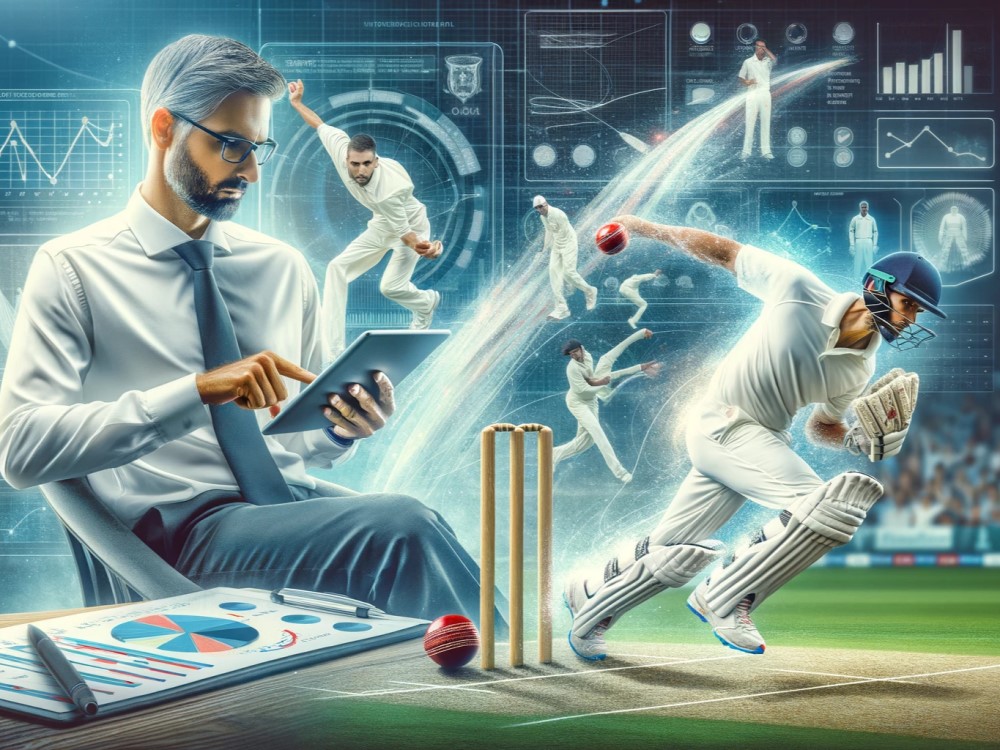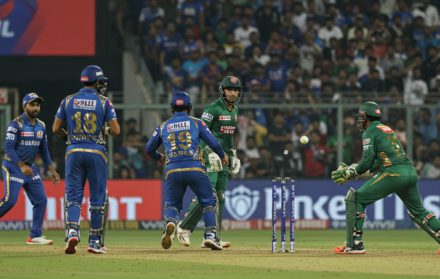
Impact of Technology in Cricket: Revolutionizing the Game in 2024
Cricket has transformed dramatically from its origins to become a global phenomenon, engaging millions around the world. This evolution has been significantly propelled by technological advancements, altering how the game is played, experienced, and enjoyed. The impact of technology in cricket has been pivotal in this transformation, making the sport more accessible and appealing to a broader audience. This 2024, we’re witnessing an unprecedented revolution in cricket, thanks to the latest technologies that are enhancing every aspect of the game.
Traditionally, cricket was a simple sport, with minimal equipment and reliance on physical skill and strategy. However, as technology progressed, its integration into sports became inevitable and highly beneficial. Today, technology is not just an add-on; it’s a crucial component in the development and execution of the game, influencing training, performance analysis, fan engagement, and even the decision-making process during matches.
The profound impact of the latest technologies in revolutionizing cricket in 2024 cannot be overstated. Wearable devices, data analytics, and virtual reality are just a few examples of how technology is enhancing player performances, improving training methods, and creating immersive experiences for fans. These innovations are not just changing the game; they’re setting a new standard for how sports can be played and enjoyed.
Cricket’s journey from a pastoral game to a high-tech sport is a testament to how technology can enhance and transform traditional practices. High-definition broadcasts and instant replay systems have made following cricket games a more informative and enjoyable experience for fans worldwide. Technologies such as the Hawk-Eye, used for tracking the trajectory of balls, have brought transparency and fairness to the game, significantly reducing human error in umpiring decisions.
Training methodologies have also seen a radical shift. Gone are the days when practice sessions were solely about physical endurance and skill enhancement. Now, with the advent of batting simulators and bio-mechanical analysis, players can fine-tune their techniques with precision, focusing on their weaknesses with detailed feedback from advanced software programs.
Moreover, the Decision Review System (DRS), which combines several technological tools, including ball-tracking and thermal imaging, has revolutionized umpiring and decision-making in cricket. This technology ensures that the outcome of games is more accurate, fair, and just, enhancing the integrity of the sport.
The way fans interact with cricket has also undergone a significant transformation. Virtual reality (VR) experiences allow fans to feel as if they’re in the stadium from the comfort of their homes, offering a new level of engagement. Social media platforms and mobile apps provide real-time updates and behind-the-scenes access to teams and players, creating a more intimate and connected fan experience.
Furthermore, the use of big data analytics in cricket has opened up new avenues for strategizing and player development. Teams now rely on comprehensive datasets to devise game plans, select players based on situational strengths, and predict the outcomes of matches with greater accuracy. This data-driven approach has not only enhanced team performances but has also added a new layer of depth to how fans understand and appreciate the game.
As we look towards the future, it’s clear that the impact of technology in cricket will continue to grow, bringing about more innovations and changes. The potential for technologies like artificial intelligence (AI) and machine learning to further enhance training, strategy formulation, and even injury prevention is immense. These advancements promise to make cricket more exciting, competitive, and accessible to future generations.
The integration of technology in cricket has been nothing short of revolutionary. As we move through 2024, we are witnessing firsthand how these technological advancements are reshaping the game, making it more dynamic, inclusive, and engaging for everyone involved. The journey of cricket’s evolution through technology is a powerful reminder of how innovation can elevate sports to new heights, offering unprecedented opportunities for enhancement and growth.
Revolutionizing the Game: The Impact of Sixes Cricket on Modern Cricket

In the modern era, the impact of technology in cricket has redefined how the sport is played, experienced, and enjoyed, extending beyond professional stadiums to innovative entertainment venues like Sixes Cricket. As a blend of restaurant, bar, and cricketing experience, Sixes Cricket has emerged as a unique player in the cricketing world, offering an engaging way for fans to connect with the game.
Sixes Cricket has pioneered the integration of cutting-edge technology with the traditional sport of cricket, creating an immersive experience that appeals to both hardcore cricket enthusiasts and those new to the game. By utilizing virtual bowlers and quality cricket batting cages within a social setting, Sixes Cricket offers guests the chance to experience the thrill of batting against world-class bowlers, without the need to step onto a cricket field. This innovative approach not only enhances the social aspect of cricket but also makes the sport more accessible to a wider audience.
The significance of Sixes Cricket in the broader context of cricket’s evolution lies in its ability to marry technology with entertainment, creating a new avenue for fan engagement. In an age where digital experiences are highly sought after, Sixes Cricket provides a tangible way for people to interact with the sport, blending the physical and digital worlds seamlessly. This is particularly impactful in regions where cricket is a beloved sport, as it offers a novel way to enjoy cricket year-round, regardless of weather conditions or outdoor space limitations.
Moreover, Sixes Cricket plays a crucial role in introducing the sport to those who may not have had the opportunity to play cricket traditionally. By lowering the barriers to entry, such as the need for equipment, playing fields, or advanced skills, Sixes Cricket democratizes the sport, making it more inclusive. This inclusivity is vital for the growth of cricket, as it opens up the sport to a broader demographic, including families, casual fans, and those looking for an enjoyable group activity.
From a technological standpoint, the advanced virtual bowling machines used by Sixes Cricket are a testament to the possibilities of integrating technology into cricket. These machines offer a realistic cricketing experience, mimicking the bowling styles and speeds of international players. This not only challenges players to improve their batting skills but also provides a unique form of entertainment that is both fun and engaging. The feedback and data generated by these sessions can also offer insights into a player’s performance, highlighting the convergence of sport, technology, and entertainment.
Sixes Cricket also contributes to the community aspect of cricket. By creating a space where fans can gather to play, watch, and discuss the game, it strengthens the social bonds within the cricket community. This communal experience is essential for fostering a sense of belonging and passion for the sport, elements that are crucial for its long-term growth and sustainability.
Looking forward, the role of Sixes Cricket and similar ventures in the future of cricket is significant. As technology continues to evolve, the potential for more immersive and interactive cricket experiences grows. Sixes Cricket is at the forefront of this evolution, showcasing how technology can be used to not only enhance the game but also to create new ways for people to engage with cricket. Whether it’s through virtual reality experiences, augmented reality games, or other technological innovations, Sixes Cricket is poised to lead the way in transforming how fans interact with the sport.
The impact of Sixes Cricket on modern cricket is multifaceted, offering a bridge between traditional cricket and the digital age. It exemplifies how technology can be harnessed to enhance the cricketing experience, making the sport more accessible, enjoyable, and engaging for a wide range of audiences. As cricket continues to evolve, the innovative approach of Sixes Cricket serves as a model for how technology can be used to bring the sport into the future, ensuring it remains relevant and beloved by generations to come.
Enhancing Player Performance and Skills
The intersection of technology and cricket has ushered in a new era where player performance and skill enhancement are more scientific and data-driven than ever before. The adoption of wearable tech, advanced simulation technologies, and video analytics has provided players and coaches with tools to refine techniques, improve fitness, and strategize more effectively.
Wearable technology has become a cornerstone in monitoring and improving player fitness and performance. Devices like fitness bands and smartwatches are now standard gear for cricketers. These gadgets track vital statistics such as heart rates, movement speeds, and distances covered during a game or practice session. The data collected offers insights into a player’s physical condition, enabling personalized training regimens that optimize performance and minimize the risk of injuries. By analyzing trends over time, coaches can make informed decisions on workload management, ensuring athletes are in peak condition for their matches.
The revolution doesn’t stop at fitness tracking. The cricket world has also embraced advanced batting and bowling simulators, which have become crucial in skill development. These simulators recreate match conditions, allowing players to practice without being on the field. They can face a variety of bowling styles and speeds in a controlled environment, which is invaluable for refining their techniques. Batting simulators, equipped with sensors and cameras, provide instant feedback on every shot, analyzing aspects such as bat speed, angle, and the point of impact. This immediate feedback loop helps players to make adjustments in real-time, accelerating the learning process.
Bowling simulators are equally sophisticated, offering bowlers the chance to work on their deliveries against virtual batsmen. These technologies can simulate different pitch conditions, allowing bowlers to adapt their techniques to various environments. This kind of practice was unimaginable a few decades ago but is now a fundamental part of training regimes in professional cricket.
Another critical technological advancement in cricket coaching and training is the use of video analytics. High-speed cameras capture every minute detail of a player’s technique during practice sessions and live matches. This footage is then analyzed using specialized software to evaluate performance and identify areas for improvement. Video analytics have been particularly transformative in fine-tuning batting and bowling techniques. For instance, slow-motion playback can reveal flaws in a batsman’s footwork or a bowler’s release that are not visible to the naked eye. Coaches can use this information to provide targeted feedback, helping players to correct minor imperfections that can make a significant difference in their overall performance.
The impact of technology on cricket goes beyond just improving physical performance; it has also enhanced mental preparedness. Simulation technologies and video analytics allow players to experience match-like conditions repeatedly, helping to build confidence and reduce anxiety under pressure. This mental conditioning is crucial for performing well in critical moments of the game.
The fusion of technology with cricket has created exciting opportunities for enhancing player performance and skills. The precise insights offered by wearable tech, the realistic practice environments provided by simulators, and the detailed analysis made possible by video analytics have all contributed to a new era of cricket training. These technologies are not just changing how players prepare; they are redefining the limits of what is possible on the cricket field.
Game Strategies and Analytics

The impact of technology in cricket is profoundly revolutionizing the game in 2024, particularly in how teams strategize and manage player health. The advent of data analytics and artificial intelligence (AI) has opened new frontiers for cricket, making it not just a game of physical prowess but also of intelligent strategy and preemptive health management.
In recent years, cricket has seen a significant shift towards data-driven decision-making. Teams and coaches now rely on big data and AI to craft winning strategies. These technologies sift through vast amounts of data, from player performance records to historical match outcomes, to provide insights that were previously unimaginable. For instance, analytics can predict an opposing batsman’s weakness or a bowler’s likelihood of success against certain players. This depth of analysis allows teams to make informed decisions on everything from team selection to field placements and bowling changes.
A notable example of this approach is how the England and Wales Cricket Board has leveraged data analytics to optimize team performance. By analyzing patterns and trends, they’ve managed to tailor their strategies against different teams, often with remarkable success. This reliance on data analytics marks a shift from gut feeling and experience to a more empirical approach to cricket strategy.
Another critical area where technology has made significant inroads is in monitoring player health and preventing injuries. Wearable devices are now common, providing real-time data on a player’s physical condition during training and matches. This data, when analyzed, can alert support staff to potential overexertion or the onset of an injury, allowing for immediate intervention.
Moreover, predictive analytics play a crucial role in assessing injury risks. By analyzing data on players’ physical exertions and match conditions, AI models can predict the likelihood of injuries. This allows teams to proactively rest players or adjust their training regimens, significantly reducing the risk of injuries. For example, the Indian Premier League(IPL) teams have been pioneers in using predictive analytics for injury prevention, utilizing the insights to manage their players’ workloads effectively throughout the grueling tournament schedule.
The integration of technology in health and fitness management has not only helped in enhancing player performance but also in extending their careers. Injuries that might have sidelined players for months, if not detected early, are now being managed more efficiently, ensuring players spend more time playing than recovering.
The synergy between game strategies and player health management underscores the comprehensive impact of technology in cricket. It’s not just about winning matches but also about ensuring the well-being of the players, who are, after all, the heart and soul of the game. This holistic approach to using technology ensures that the game continues to evolve, not just in the tactics employed on the field but also in how players are cared for off it.
In 2024, as we witness these technological advancements unfolding, it’s clear that the impact of technology in cricket has been nothing short of revolutionary. The game is no longer just about talent and hard work. It’s about how effectively teams can leverage technology to enhance their strategies and safeguard their players. This evolution has made cricket more exciting and unpredictable, with data analytics and health management playing pivotal roles in shaping the future of the sport.
As technology continues to evolve, its integration into cricket is expected to deepen further, offering even more sophisticated tools for strategy formulation and health management. The potential benefits are immense, from developing unbeatable strategies based on AI’s predictive powers to creating near-bulletproof health management protocols that keep players at their physical peak.
The future of cricket, influenced heavily by technology, looks brighter and more exciting than ever. The journey from traditional cricket to a tech-driven spectacle underscores the transformative power of technology, ensuring that the game remains relevant and thrilling in an ever-changing world.
Enhancing Audience Engagement and Experience
This 2024, the impact of technology in cricket has transcended beyond the pitch, dramatically enhancing how fans engage with the sport. The advent of Virtual Reality (VR) and Augmented Reality (AR), alongside the ubiquitous presence of social media and digital platforms, has revolutionized the fan experience, making cricket more interactive and accessible to a global audience.
Gone are the days when watching cricket was a passive activity. Today, VR and AR technologies are turning fan engagement into an immersive experience. Through VR headsets, fans can now enjoy a 360-degree view of the match as if they were sitting in the stadium, regardless of their physical location. This technology brings the excitement of the game to fans who can’t attend the matches in person, bridging the gap between the stadium and the living room.
AR apps take this a step further by overlaying digital information onto the real world, enhancing the live game with stats, player information, and more. Imagine pointing your phone’s camera at the TV during a live match and instantly getting statistics about the player currently batting. This layer of interactivity enriches the viewing experience, making it more engaging for fans.
One notable example of AR in action is at The Oval in London, where fans used an AR app to unlock exclusive content and experiences during the match. These technologies are not just gimmicks; they represent a new era of fan engagement, offering a richer, more informative, and interactive experience.
The digital revolution has also transformed how fans connect with their favorite teams and players. Social media platforms like Twitter, Instagram, and Facebook have become vital tools for fan engagement and community building. Teams and players share behind-the-scenes content, match highlights, and personal stories, providing fans with a glimpse into the lives of their cricketing heroes.
Digital platforms have also become a primary source of news, updates, and live scores, keeping fans in the loop wherever they are. The Indian Premier League (IPL), for example, has leveraged its digital presence to become one of the most followed cricket leagues in the world. Its use of social media for live updates, engaging content, and fan interactions has set a benchmark for how sports leagues can build and maintain a passionate fan base.
Moreover, digital platforms offer a space for fans to interact with each other, creating global communities of cricket enthusiasts. These online forums and social media groups allow fans to share their views, celebrate wins, and commiserate losses, fostering a sense of belonging and community.
The combination of VR, AR, and digital platforms has not only made cricket more accessible but has also added a new dimension to fan engagement. These technologies allow fans to experience the game in ways that were once unimaginable, bringing them closer to the action and their favorite players.
Looking ahead, the role of technology in enhancing audience engagement and experience is only set to grow. Innovations in VR and AR could lead to even more immersive experiences, such as virtual meet-and-greets with players or AR-enabled merchandise that brings fans even closer to the game.
Social media and digital platforms will continue to evolve, offering new ways for fans to connect with the sport and with each other. The potential for personalized content, based on fans’ preferences and viewing habits, could make every fan’s experience unique.
The impact of technology in cricket has fundamentally changed how fans interact with the sport. The advent of VR and AR, combined with the power of social media and digital platforms, has created a more immersive, interactive, and personalized fan experience. As we move further into 2024, these technological advancements promise to deepen the connection between cricket and its global fan base, making the sport more vibrant and accessible than ever before.
Innovations in Cricket Equipment

The impact of technology in cricket has significantly transformed not just how the game is played and viewed but also the very tools of the trade. In 2024, innovations in cricket equipment, particularly through the integration of smart technologies and enhanced safety features, are setting new standards in the sport. This revolution is evident in the development of smart cricket bats and balls, as well as in the advanced safety gear now available to players.
The traditional cricket bat and ball have received a high-tech makeover, significantly influencing player training and performance analysis. Smart cricket bats, embedded with sensors, are a groundbreaking innovation in this domain. These sensors capture detailed data on every shot played, including the bat’s speed, angle, and the point of impact with the ball. This information is instantly relayed to players and coaches, providing immediate feedback that can be used to refine techniques and improve performance.
One of the leading examples of this technology is the PowerBat technology, developed in collaboration with Microsoft and Spektacom. Used in professional leagues, such as the Indian Premier League (IPL), it offers insights into the batsman’s playing style and efficiency, enabling personalized coaching and development strategies.
Similarly, smart cricket balls equipped with microchips have made their way into the game. These balls can measure speed, spin, and bounce accurately, offering a deeper analysis of a bowler’s delivery. This technological advancement not only aids players in honing their skills but also enhances the viewing experience for fans, providing them with detailed statistics during live broadcasts.
As the game gets faster and more competitive, ensuring player safety has become a paramount concern. Technology has played a crucial role in the evolution of safety gear, with new materials and designs offering better protection without compromising on comfort or mobility. Helmets, for instance, have seen significant improvements. Modern cricket helmets are not only lighter and more comfortable but also offer better shock absorption and protection against high-speed deliveries.
The development of impact-sensing technology in helmets is a notable advancement in this area. These helmets come equipped with sensors that can detect the severity of an impact, providing immediate data on potential concussion risks. This technology is instrumental in making quick decisions about a player’s fitness to continue in the match, significantly reducing the risk of long-term injuries.
Moreover, protective gear such as pads and gloves has also seen technological enhancements. Materials that are both lightweight and highly protective are now used, allowing players to move freely while being adequately shielded against injury. Smart vests, which monitor heart rate and impact, are increasingly being used in practice sessions to ensure player well-being.
The introduction of smart equipment and enhanced safety gear in cricket has not just been about adopting new technologies; it’s about fundamentally changing how players train, perform, and stay safe on the field. Instant feedback from smart bats and balls allows for real-time adjustments, making practice sessions more productive and tailored to individual needs. This specificity in training is crucial for player development, enabling precise improvements that can make a significant difference in match situations.
On the safety front, the advancements in protective gear have been a game-changer. With players often facing balls bowled at high speeds, the enhanced protective equipment provides a much-needed assurance of safety, allowing players to focus on their game without fear of injury. The integration of technology in safety gear also means that potential injuries can be quickly assessed and managed more effectively, ensuring players’ health is always a priority.
As we continue through 2024, the impact of technology in cricket is increasingly evident in the equipment used by players. Smart cricket bats and balls are revolutionizing training and performance analysis, while advancements in safety gear are ensuring that the sport remains as safe as it is competitive. These innovations are not just enhancing the game for players; they are also improving the experience for fans, coaches, and administrators, making cricket more engaging and enjoyable for all involved.
In the world of cricket, technology has become an indispensable ally, driving the sport forward in ways previously unimaginable. As these technologies continue to evolve, they promise to bring about even more exciting changes, shaping the future of cricket in ways we can only begin to imagine.
Challenges and Ethical Considerations
While the impact of technology in cricket is undeniably revolutionizing the game in 2024, bringing in advancements that enhance performance, safety, and fan engagement, it also presents unique challenges and ethical considerations. Integrating these technologies into a sport with a rich tradition like cricket raises questions about balancing modern innovations with the game’s heritage. Additionally, issues around the accessibility of these technologies and their implications for fair play are becoming increasingly important to address.
Cricket is steeped in tradition, with a history that spans over a century. The introduction of high-tech equipment and analytical tools has sparked debates among purists who fear that excessive reliance on technology may dilute the essence of the sport. For example, while Hawk-Eye and the Decision Review System (DRS) have made cricket fairer, some argue that they undermine the authority of on-field umpires and the traditional aspect of human error being part of the game’s charm.
The challenge lies in integrating technology in a way that respects cricket’s traditions while embracing the benefits that innovations bring to the game. This requires a delicate balance, ensuring that technology serves as an aid rather than becoming the focal point of the sport. Governing bodies like the International Cricket Council (ICC) play a crucial role in this, setting regulations that dictate the extent and manner in which technology can be used, ensuring it enhances rather than overshadows the sport.
Another significant concern is the accessibility of advanced technologies, which can vary greatly between wealthy and less affluent cricketing nations or even among domestic teams. High costs associated with implementing technologies like real-time performance tracking systems or advanced analytics software may widen the gap between rich and poor teams, potentially affecting the level playing field that sports strive to offer.
This disparity raises ethical questions about fairness and equality in cricket. If only a subset of teams or players has access to the latest technological tools for training and performance analysis, they could gain an unfair advantage over their competitors. This not only impacts the competitiveness of the sport but also its integrity.
Moreover, the use of technology in cricket extends beyond professional levels to grassroots and amateur levels, where the disparity in access becomes even more pronounced. Ensuring that the benefits of technology are accessible to all, regardless of their financial backing, is a challenge that cricket’s governing bodies and the wider cricket community must address.
The rapid advancement and integration of technology in cricket also bring about ethical considerations related to data privacy and the potential for misuse. Wearable tech and analytics tools collect vast amounts of personal data from players, raising concerns about who has access to this data and how it is used. Ensuring that data privacy laws are adhered to and that players’ personal information is protected is paramount.
Additionally, the potential for technology to be misused, such as unauthorized enhancements to equipment or exploiting data analytics for unsporting purposes, poses a risk to the game’s integrity. This necessitates robust frameworks and regulations to govern the use of technology in cricket, ensuring that it is used ethically and in the spirit of the sport.
Addressing these challenges and ethical considerations is crucial for ensuring that technology continues to benefit cricket without detracting from its essence or fairness. This involves ongoing dialogue among all stakeholders, including players, coaches, governing bodies, and fans, to find common ground that respects cricket’s traditions while embracing innovation.
Moreover, initiatives to improve the accessibility of technology in cricket, such as funding schemes for less affluent teams or the development of more cost-effective technological solutions, can help level the playing field. Ensuring fair play and ethical use of technology will be pivotal in maintaining cricket’s integrity and ensuring that the sport remains competitive and enjoyable for everyone involved.
The impact of technology in cricket in 2024 is a double-edged sword, offering incredible opportunities to revolutionize the game while presenting challenges that need careful navigation. Balancing tradition with technology, ensuring accessibility and fair play, and addressing ethical implications are all crucial for harnessing the benefits of technology in cricket. As the sport continues to evolve, finding solutions to these challenges will be essential for ensuring that cricket remains a beloved and fair competition for generations to come.
The Future of Cricket: Navigating Technology’s Impact Beyond 2024

The transformative impact of technology in cricket has reshaped the sport at every level, from player performance and safety to fan engagement and strategic decision-making. As we’ve explored throughout this article, these advancements offer a glimpse into a future where cricket is not only more engaging and accessible but also fairer and more competitive.
Technology has provided players with tools like smart cricket bats and balls, wearable fitness devices, and advanced video analytics. These innovations have made training more precise and personalized, allowing players to fine-tune their skills with instant feedback. The use of simulation technologies for batting and bowling practice has also enabled cricketers to prepare for a wide range of scenarios, enhancing their performance on the field.
Data analytics and AI have changed the game’s strategic landscape, enabling teams to make informed decisions based on comprehensive data analysis. From formulating match-winning strategies to managing player workloads for injury prevention, technology has become an indispensable part of modern cricket strategy.
The fan experience has been dramatically enhanced through VR and AR, providing immersive viewing experiences that bring spectators closer to the action, regardless of their physical location. Social media and digital platforms have further bridged the gap between players and fans, creating vibrant communities of cricket enthusiasts worldwide.
Innovations in cricket equipment, particularly the development of smart cricket bats, balls, and enhanced safety gear, have not only improved player performance but also significantly increased safety standards. These advancements ensure that players can compete at the highest levels while minimizing the risk of injury.
Despite the numerous benefits, the integration of technology in cricket has also presented challenges, particularly in balancing tradition with innovation, ensuring accessibility and fair play, and navigating ethical considerations around data privacy and the potential for misuse. Addressing these issues is crucial for ensuring that technology continues to serve the sport positively.
As we look beyond 2024, the role of technology in cricket is set to expand further, driven by continuous innovation and the increasing digitalization of the sports industry. We can expect to see even more sophisticated data analytics, AI-driven training tools, and immersive fan experiences, alongside advancements in equipment technology and player safety measures.
However, as technology evolves, the cricket community must remain vigilant in addressing the challenges and ethical considerations that come with it. Ensuring that technology enhances the sport without undermining its integrity or accessibility will be key to its successful integration in the future.
Technology has undeniably revolutionized cricket, making it more exciting, engaging, and fair. As we move forward, the continued integration of technological innovations promises to enrich the sport even further, offering new opportunities for players to excel, fans to connect, and the game to grow globally. The future of cricket, shaped by technology, looks bright, filled with possibilities that were once unimaginable.
By embracing the benefits while carefully navigating the challenges, cricket can continue to evolve, preserving its essence while exploring new frontiers. The impact of technology in cricket is a testament to the sport’s adaptability and resilience, ensuring that it remains relevant and beloved by millions around the world for generations to come.





